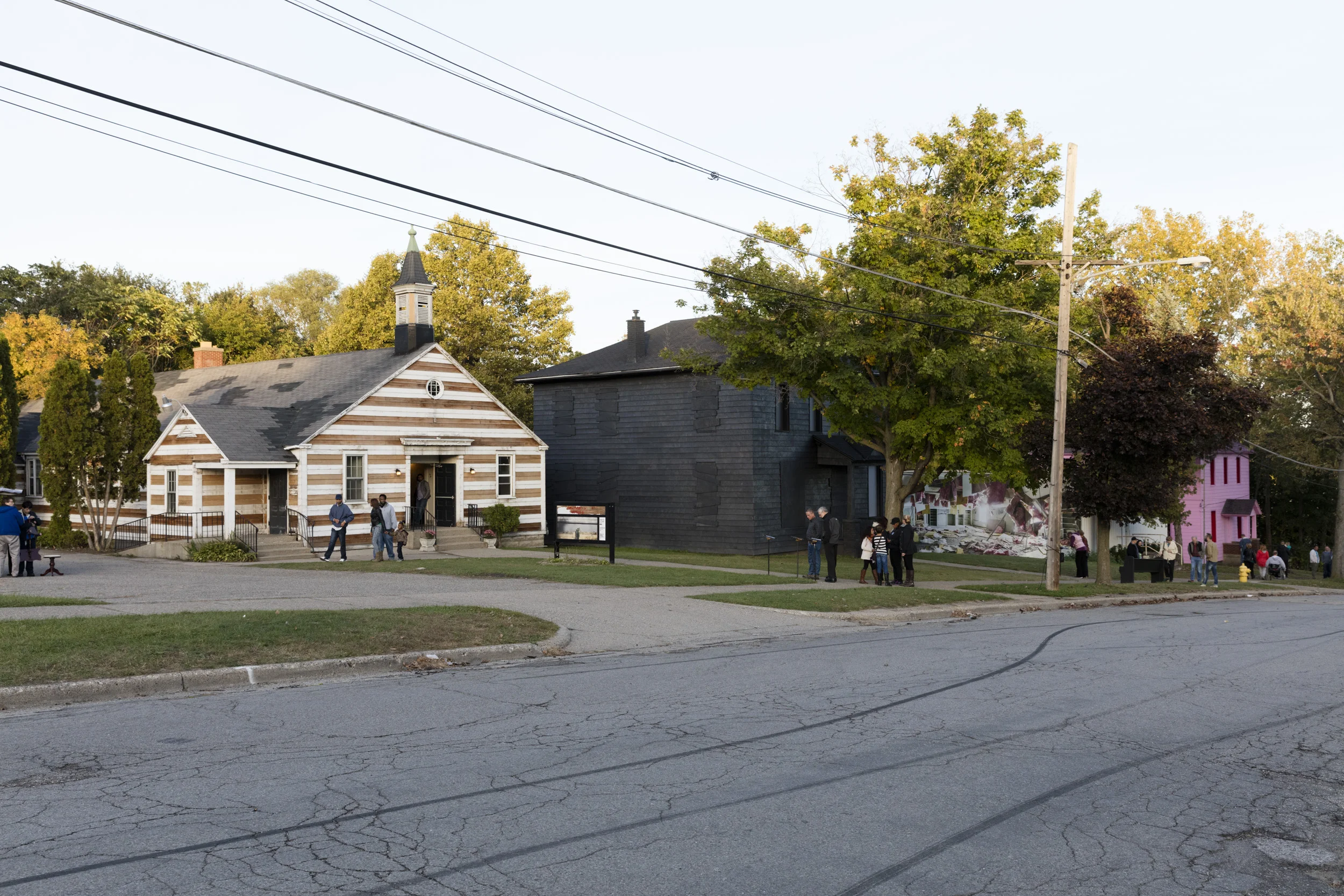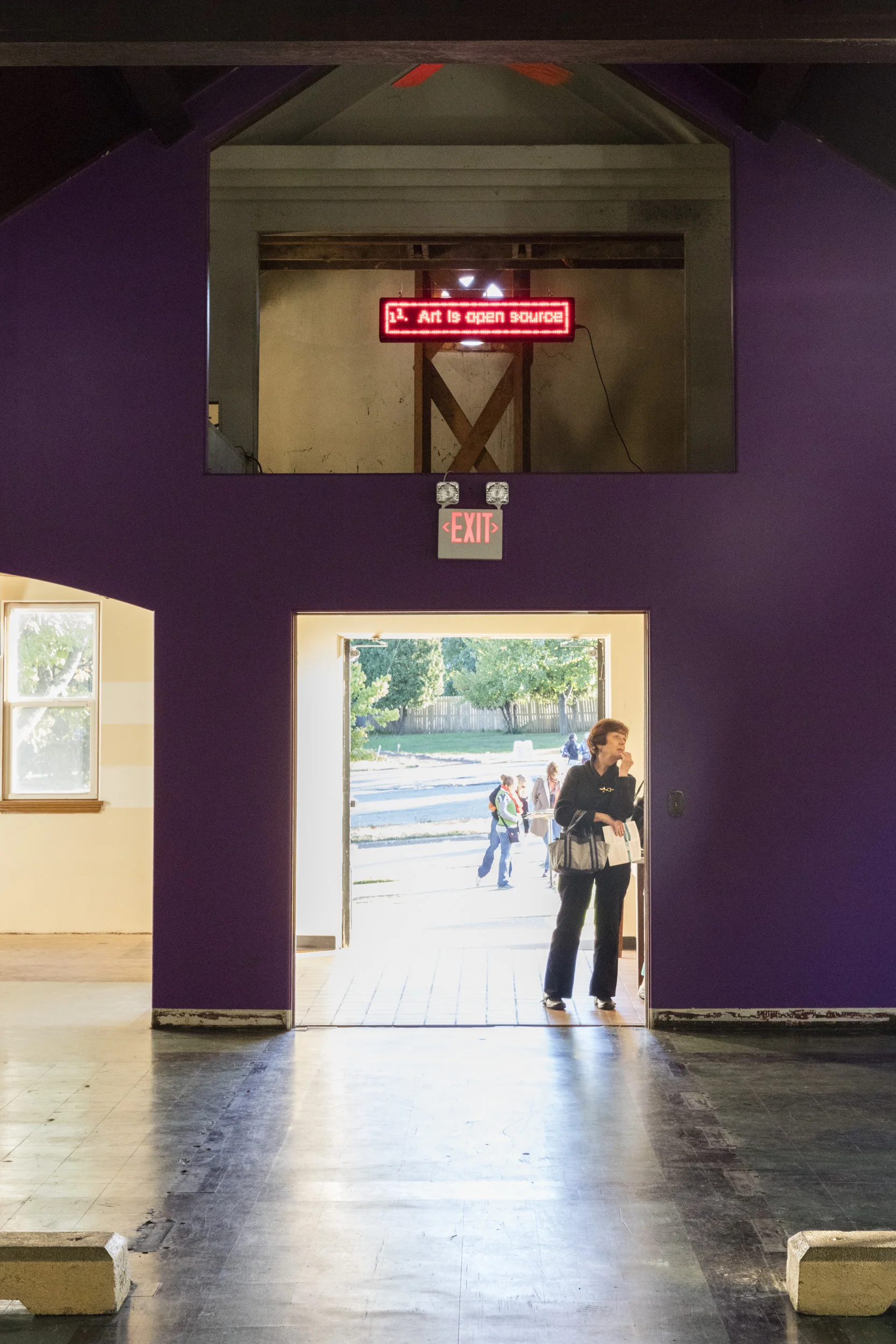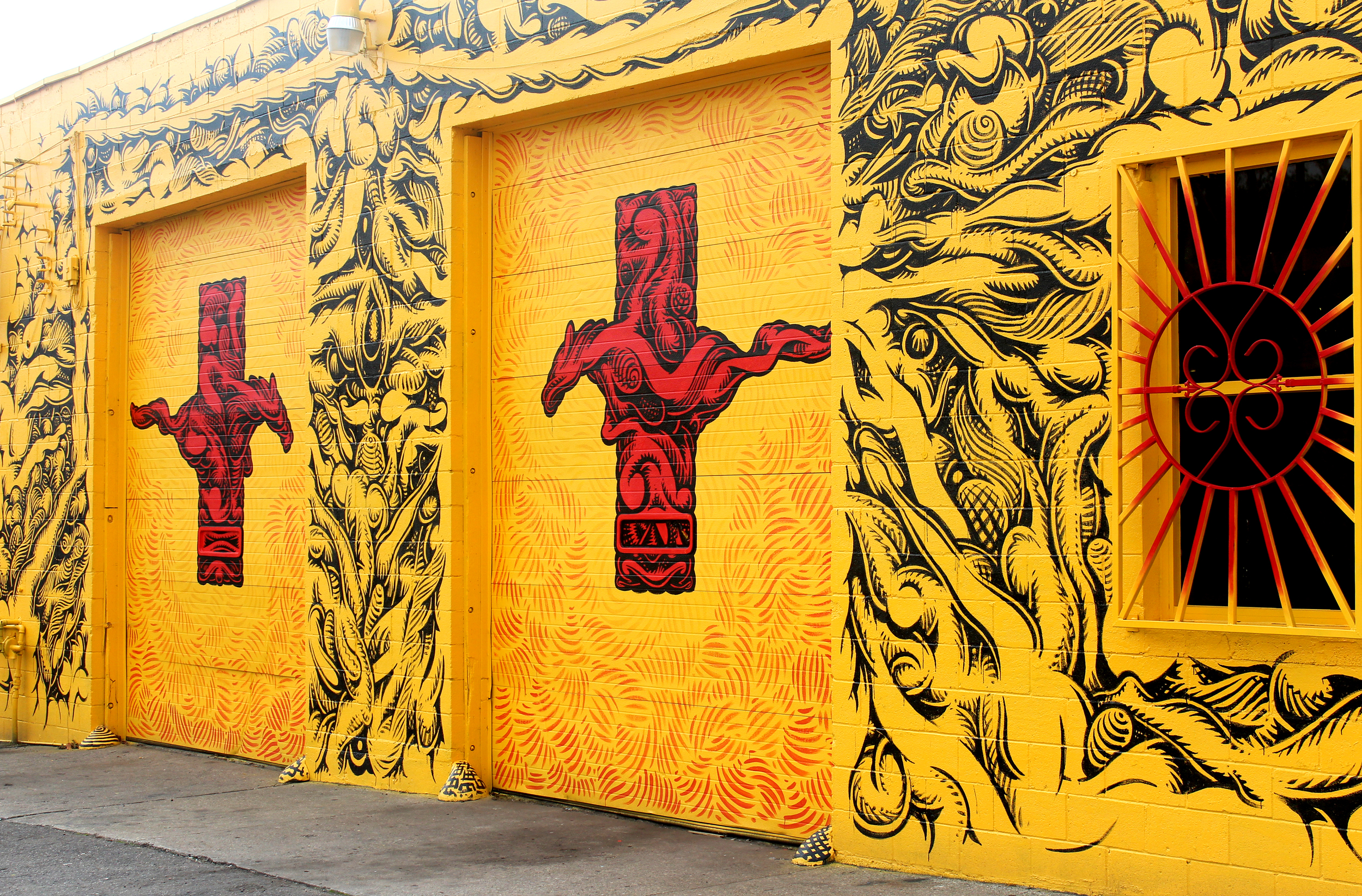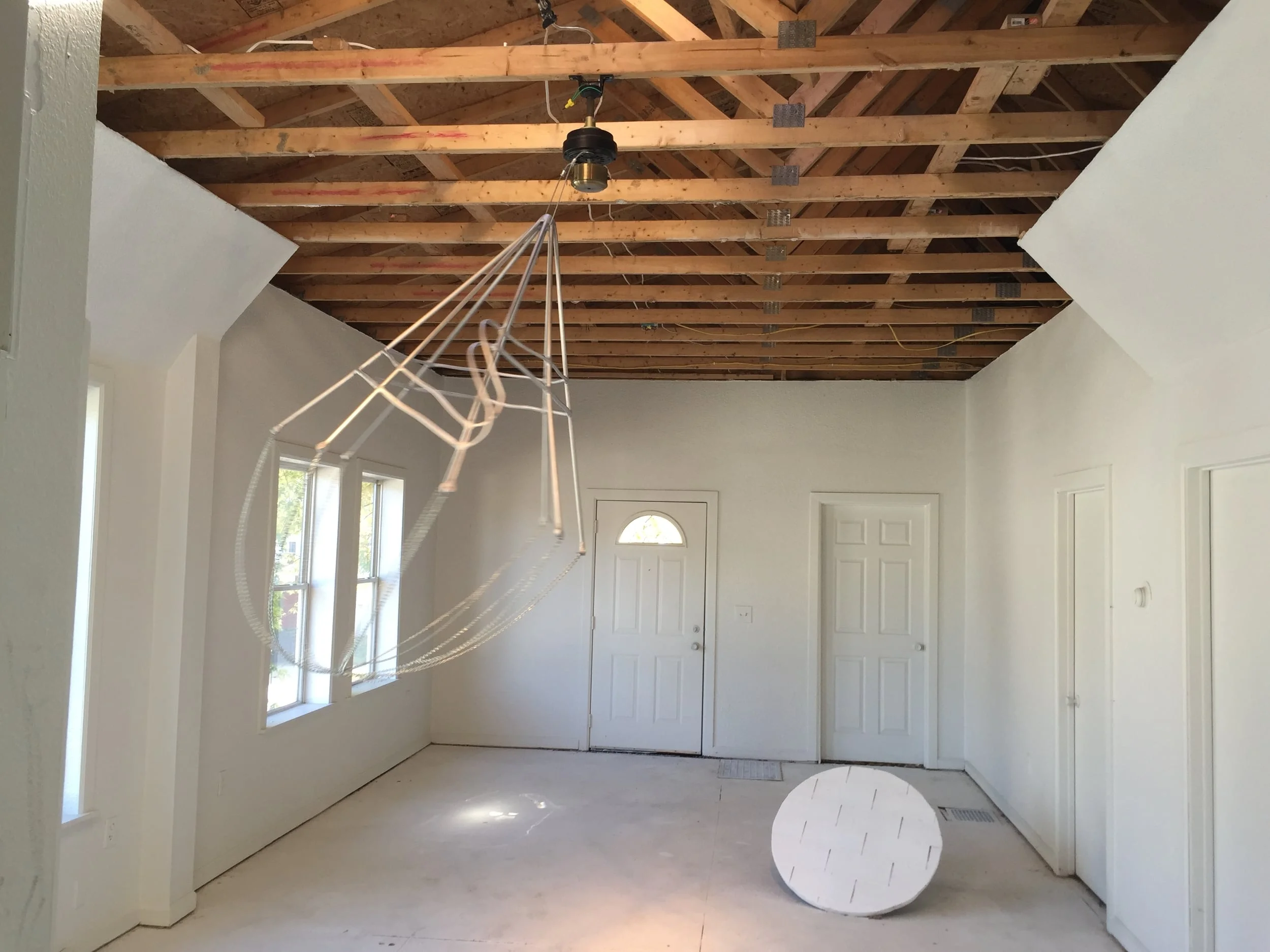







































Hyperallergic Best of 2015: Our Top 10 Exhibitions Across the United States
"It's easy to do ruined-space and abandoned-building art badly, much harder to do it well. Michigan nonprofit SiTE:LAB has become something of a master of the form, as proven by its project for this year's ArtPrize." —Jullian Steinhauer, Hyperallergic
“Every experience with SiTE:LAB is a revelation, a new discovery, a fresh encounter with what it means to live, see, think, and feel. They make impeccable matches between sites and artists who activate these once forlorn spaces and turn them into magnificent phenomena that no one could have possibly imagined before.” —Lisa Freiman, Professor, Virginia Commonwealth University
For 2015 and 2016, SiTE:LAB was presented with a unique opportunity for its most ambitious project to date. Habitat for Humanity of Kent County in Michigan offered SiTE:LAB the use of nearly three acres of land in Grand Rapids’ Roosevelt Park neighborhood. The land and existing structures were transformed into a temporary art center and residency until Habitat began its redevelopment of the properties in 2017.
This was a community based project, working with the City of Grand Rapids, Habitat for Humanity, community partners and local groups as well as local schools and universities. The SiTE:LAB team was excited to work with, and highlight the Roosevelt Park neighborhood.

Higher Ground
Kate Gilmore
Kate Gilmore’s contribution to the Rumsey Street Project involves the transformation of one of the residences to accommodate a performance that can be seen through out the duration of ArtPrize 7. Gilmore’s work explores the dynamics of power and the construct of femininity. Her Rumsey Street project includes some of the characteristic elements of her performance work, including identically dressed female performers engaged in repetitive activities. Typically the actions and costumes are informed by the particular history or context of the space in which the performance is staged. The setting is a building that was once a private home, and was later used as a convent. Working in shifts, as many as nine women in long white dresses and red shoes, will swing on swings mounted from the ceiling in front of open windows. The exterior is painted bright pink, and lit from within, which will allow the viewers to see the performers

Relocations
Filippo Tagliati
This project is a site-specific installation that started out as a personal reaction to my desire to understand the story of this anonymous and long ago abandoned building. Ultimately through the process of making an artwork for this site I ended up questioning the idea of departure and relocation.
The dismantled and abandoned status of this site makes it hard to believe that this location served originally as a church, then as a school, a parochial school, a storage space, and even a pantry. This represents 126 years of history and as it happens I will be the last person to utilize this building in an official fashion before its planned demolition.
The central piece of my installation, an 86 foot long billboard wrapping around the side of the building, showcases the inside of the place as I found it. Inside the space, a person feels that they have entered a time capsule. Time “stopped” here some years ago and it feels like some sort of cataclysm or unexpected event forced a rushed overnight evacuation. The reality of the events that led to this site’s condition is much less catastrophic and dramatic than that portrayed in my photographs. The community simply outgrew the church and the other buildings on Rumsey Street, they slowly abandoned them and they relocated to a bigger site. Time took care of the rest. Melancholy is not necessarily found here since the relocation move resulted in a better location and condition. My installation reminds us that the artifacts of this site tell a story and that this story will diminish and will be relinquished to distant memory when this place meets with its final demolition.

Drawing of a House (Triptych)
Diana Shpungin
It starts with a pencil, a fundamental tool universal in its function and familiarity.
Diana Shpungin’s Drawing Of A House (Triptych) is a large scale, multi-faceted participatory work consisting of drawing, sculpture and hand drawn video animation, functioning as one over all monumental installation and community project for SiTE:LAB in partnership with Habitat for Humanity of Kent County and The City of Grand Rapids. The vacant house is converted into a massive sculpture and three-dimensional drawing by way of it being entirely tediously encased by hand in graphite pencil. While selected windows of the home double as screens, exploring narratives related to the domestic themes embedded in the historical memory of the space -- past, present and future, through ambiguous themes of still life, figuration and abstraction. The (Triptych) in the title of the work refers both to the home’s address (333 Rumsey Street) and to the three loose narratives taking place on the three sides of the home.

Stripes for St. Joseph
Nick Kline
From the outside, many houses of worship are white, yet the color of the building is no indicator of who worships within its walls. When I first visited the deconsecrated church on Rumsey Street, previously called St. Joseph the Worker, it triggered many feelings and memories, on the one hand of my childhood growing up in a Catholic family, and on the other of the recent terrorist attack on Emanuel AME Church in South Carolina. In the aftermath of the tragedy, a friend on Facebook posted a comment asking why there are no attacks on white churches. His question led me to ask, “What is a ‘white church?’” Rather than provide answers, I hoped to create a space that promotes questioning, blurring the differences between exterior and interior virtually using only the structure itself as material in order to activate the site.
Stripes are a recurring theme in my photography and during my research into St. Joseph, I discovered that in the Middle Ages he was represented in visual art with stripes on his breeches in order to mark him as different, difficult, marginalized, but somehow significant. This fact made me want to put stripes on the abandoned building to create a visual pattern that evokes a restoration in progress. Instead of adding another layer of paint, I chose to uncover the original cedar boards by sanding away the white paint to reveal the building’s inner structure. The stripes continue as white lines painted inside the church, which seem to radiate from a cloudy apparition (caused by a water leak and repatched with cement) on the wall behind the former altar. Former concrete parking lot barriers painted gold become the new pews for viewers to sit on, and sawdust collected from sanding the cedar boards now resides in a glass urn – like ash remains.
The work attempts not only to examine the literal structure of the church, but also by association, to consider the structure of whiteness and racism, while creating a living shrine with new icons that suggest something familiar and welcoming to those who previously attended this church.

cHURCH OF MONIKA
Monika Wuhrer
The cHURCH OF MONIKA is an ongoing, art conversation series based out of Open Source Gallery in Brooklyn, New York that seeks to communicate and demonstrate the role that art can and should play in communities. Complete with its own art-related commandments and conceptually indebted to the Rothko Chapel in Houston, Texas, a profound monument to self-reflection, the cHURCH OF MONIKA gathers artists, academics, community leaders, and neighbors for conversation and exchange.
At Rumsey Street, the cHURCH will take place within a desanctified Catholic church, converting the space into music venue. The project will offer both professionals and amateurs the opportunity to use to stage by scheduling their own 20-minute performances. All performers will receive the same amount of time, same equipment, and same level of support. Through collaborations with local organizations, the project will present a diverse array of performers and music from the communities surrounding Grand Rapids.

Uncultivated
Lynn Cazabon
Uncultivated is a multipart, indoor and outdoor installation focused on wild plants that uses the landscape surrounding a decommissioned Catholic church on Rumsey Street to geo-reference photographs of plants commonly known as ‘weeds’. The photographs are displayed within a site-specific installation inside the church and one is featured on a public billboard along Grandview Ave. SW, on the shuttle route to SiTE:LAB. The images are also posted on the project website (http://uncultivated.info) along with detailed information on all the plants appearing in them. The project will include public programming centered on local wild plants in collaboration with local forager and author Lisa M. Rose. Uncultivated at SiTE:LAB is the continuation of a larger project that has been realized in six U.S. cities.

Pony Show
Mark Dean Veca
Pony Show puts the Cult in car-culture. Mark Dean Veca’s monumental mural installation is a shrine to the American Car, particularly those that rolled out of Detroit in the 1960’s like Veca’s first car the Ford Mustang (which sparked a new denomination, the Pony Car). Painted in Carbon Black, Candy Apple Red, and Glorious Gold on the exterior of a former auto repair shop, it’s roll-up doors are emblazoned with the cruciform Mustang logo and framed by Pop-Baroque ornamentation – a psychedelic synthesis of Gianlorenzo Bernini and Rick Griffin. At once celebrating and criticizing our fanatical devotion to the automobile, Pony Show is a schismatic spectacle of epic proportions.

State of Exception
Jason De Leon, Richard Barnes, Amanda Krugliak
State of Exception presents traces of the human experience – objects left behind in the desert by undocumented migrants on their journey into the U.S., all collected as part of the research of U-M anthropologist Jason De León’s Undocumented Migration project. This exhibition created by artist/photographer Richard Barnes and artist/curator Amanda Krugliak, in collaboration with anthropologist De León, includes an installation of hundreds of backpacks left behind by migrants crossing the Arizona desert, as well as video images created by Richard Barnes on location along the Mexico-United States border. It also includes original recordings from audio interviews with migrants, documenting their experiences. State of Exception attempts to convey the complexity and ambiguity of these found artifacts and what they may or may not reveal in terms of transition, culture, commerce, violence, accountability, and our most fundamental sense of humanity. It offers the opportunity to re-think cultural objects, how we collect and organize them, further informing the contemporary conversation about immigration.
This exhibition is created by artist/photographer Richard Barnes, artist/curator Amanda Krugliak, in collaboration with UM anthropologist Jason De León and his crew. This exhibition was made possible with the support of the University of Michigan Institute for the Humanities.

Undocumented Histories
Mandy Cano Villalobos
Undocumented Histories reimagines the stories of the lifelong occupants and nameless wanderers that have occupied the Rumsey Street neighborhood over the years. The work consists almost solely of remnants found in the abandoned buildings. Recontextualized, these remnants present a fragmented narrative that straddles fact and fiction, past and present, and ultimately challenges the viewer to question their own nostalgic desires.

Oculus
Daniel Rothbart
A large circular hole will be cut in the roof of 349 Franklin Street to create an oculus, permitting a shaft of light to pass through the house and illuminate the floor. A motorized sculpture, attached to a ceiling truss, will spin continuously beneath the oculus. Centrifugal force will throw the sculpture off-center while it spins and the linear elements of its construction will cast web-like shadows on the walls and floor of the house. The patterning will change over the course of a day as the sun moves across the sky.Empty Vessels Make The Loudest Sound, a musical composition by Patrick Grant, will play within the installation. This music was created using digitized vessel sounds from Daniel Rothbart sculptures.

Rumsey Street Office of the Archivist
Mark Rumsey
The Rumsey Street Office of the Archivist explores the ways in which we have categorized this specific place over time. The way those methods of categorizations have changed, the way that the landscape has changed -- both its physical form and the changing tides of its habitation. The process of categorization allows for points of disruption depending upon what information is privileged and collected. The privileging of certain information over others reflects specific attitudes of those charged with its collection and the cultural norms of the time period it was collected in.
The Rumsey Street Office of the Archivist offers a matrix in which attendees may engage. Historic photos of the structures built in the area are presented as a greyscale wall paper. As you enter the Office you are invited to Register, providing some basic information -- First Name, Gender, Day and Month of Birth, etc. After completing your registration card you may present it to one of the Clerks on duty, who will scan the inside of your forearm for a color match. The dominant color reading will be added to your registration card. After completing registration you will be given a color sticker that matches one of the images on the wallpaper. You may keep the sticker or find its match on the wall and apply it over the original image, slowly shifting the wall paper from grey to color.
The collected registrations will be developed into a daily report about the attendees, with the previous days report being available for review at the beginning of each day of operations.

Geometric Flood
Tomas Rivas, Ignacio Rivas
We are brothers sharing a studio and collaborating with other artists, designers and manufacturing companies in Chile. Our artist work deals with the genealogical tensions between two- and three-dimensional systems and fluctuates between drawing, sculpture and architecture. Playing with linear perspective, ornamentation, and unorthodox materials, it also investigates how the viewer’s cultural expectations frame perception. Our research relates to the complexities of space representation; we look into the historical foundations of monument and ornament as expanded architectural forms. Our attempt is to expose the cultural charge embodied in certain forms and styles, and the power they radiate. We believe the potency of the work is embedded in the contrast between ornamental forms identified with elitist Western ideals of high art and between the unconventional treatment of “low” and perishable materials such as thread, fabric bands, paint and other ways of making three-dimensional drawings in real spaces.
This project was made possible through the support of the Embassy of Chile and the LATAM Airline Group.

res345
Curator: Amy Wilson
As part of the new ArtPrize curatorial fellowship program, SiTE:LAB’s exhibition also includes res345, an exhibition curated by Amy Wilson. Wilson is the founder and creative director of Dance in the Annex (DITA), a Grand Rapids-based dance collective. DITA is a fixture in SiTE:LAB exhibitions, and Wilson’s 2014 ArtPrize entry at SiTE:LAB, respirador (breather), was the winner of the juried award for best time-based work.

For the Toward
BOOMERANG
For the toward is a performance which exists as a duet and a solo. The performer(s) strain against crushing weight. They coax, ride, and hurl steel sculptures that are the immediate result of relentless labor. Raw energy channeled into athletic grace is absorbed by the performer(s) as they maneuver such weight. As they balance on shaky weight, they attempt to create a bearable environment in which to exhale and endeavor.
For the toward was made in a collaborative creation process: choreography by Kora Radella; duet performance by Will Arbery and Matty Davis; solo performance by Matty Davis; text by Will Arbery; and sculpture/installation by Matty Davis. The very first iteration of the duet For the toward was created in 2014 followed by work on a longer iteration of the duet in 2015. The solo version of For the toward was created in 2015.

Breakwall
Megan Pitcher
Breakwall includes several iterations of participatory, open sourced movement and ensemble sound art with the body as instrument. This work explores the underlying openness of body-centric philosophies in contrast to the limiting processes of acculturation. I reference bodies as original source material and instigate movement exploration as a method for reconsidering social boundaries. Breakwall highlights the similarities between feedback systems and identity formation. In both cases, physical acts are compounded and magnified through repetition, accumulation, distribution, and reconstruction. We are not defined by a single act, but we grow to become representations of our collected actions. This interdisciplinary work combines installation, performance, new media, and social practice. Sound art created through real time processing via original Max MSP patch by artist Megan Pitcher with support from Leo Selvaggio. Movement development with support from Angela Luem and the performers. Special thanks to DITA for in-kind support.

How to Feed a Wolf
Lora Robertson
How To Feed A Wolf is a site-specific installation of found objects in combination with projected film. This work is a study of displacement and its broad effect on the poetic function of metaphor. The wreckage of a wooden boat is suspended in the rafters of a dormant garage. Nine panels of scrim float beneath it, as projection runs through the gossamer layers, with two projectors pointed at each other from opposite walls of the room. The two films show images of ritual and the verdant earth. The films advance and slowly collide at the central panel, creating a dissonant sense of place, one connected to earthy wandering and the other worried for the stability of attachment. A collection of amber glass bottles, relics left by an antecedent family, will be mounted as treasures on the walls. Their place in the world is uncertain. A careful assembly, but not important enough to travel ahead.

Disembodied Women
Jessica Bonenfant Coogan
Disembodied Woman is fearless. We ask what it means to let yourself be looked at – and are brave enough to open up the liminal space between looking and touching. We hope to present an interactive and thought provoking experience about the ownership of women’s bodies, objectification, and rape culture by blurring the boundaries between performer and observer.
Disembodied Woman at ArtPrize will bring together performative research experiments created since 2011. Beginning with a residency at Performing Arts Forum in St. Erme, France, previous iterations have taken place in Brooklyn, NY at Micro Museum, ShapeShifter Lab, Triskelion Arts, and the Itinerant Performance Art Festival at Grace Exhibition Space. Chashama presented the project as a week-long installation in a storefront window in Manhattan’s Garment District, which was supported by a grant from the National Endowment for the Arts.

They Were Displaced...And Again
LaMarre and Dancers Featuring James Cornish
They Were Displaced...And Again is a live site-specific modern dance and music collaboration created exclusively for ArtPrize 2015 at the Site:Lab the Rumsey Street Project venue. The issue of internal displacement is the base of thought for this work with hopes of drawing attention to the issues and emotions of people being forced to leave their homes and relocate due to natural disasters, war, generalized violence, or other conflicts. Each performance will be located in different corners, rooms, and spaces. This forces the performing artists to relocate, to restructure, to reevaluate, and start over again and again. Each time new and innovative results emerge. As the performers enter their designated area, they will face the challenge of using their unknown surroundings to create an original work on the spot. The dancers and musicians must communicate without words to complete their composition and audiences will experience the process directly. A white dust will represent the form and structure displaced communities re-build as they learn to reestablish and reconstruct a new home and social union. As each performance concludes, so does its actuality. What is left behind is only dust. The displaced participants, being forced to flee their established residence, will never return, their existence may or may not be known to people passing through at a later time.